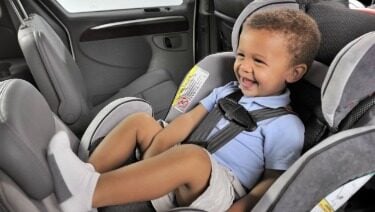Are you a parent or guardian? Do you have children? Are they grown-ups or twelve-year-olds? Do you buckle up when you drive? Do you own a child restraint for their protection and safety in your car? Or do you, like most others, trust that with or without a car seat or child restraint, their safety is guaranteed by Almighty God?
If your answer is yes, then you’re the one my piece focused on last week. When I charged parents and guardians like you last week to buckle up their children, I shared with you how much I love and cherish my sons and how much their safety, especially in a vehicle, is a priority to me. Like I told you, I have three sons who have all grown to become men. What this means is that my concern is no longer about getting the appropriate child restraints as recommended but ensuring that they buckle up always.
If your own children are yet to become adults, then you should, in the words of my learned colleagues, take judicial notice of this piece on seat belts with a focus on child restraints. Last week, I shared with you the objectives of seatbelts in vehicles. I told you that seatbelts are a secondary safety device with several objectives. One of its objectives is to prevent ejection from the vehicle in the event of an impact. Another is reducing the risk of contact with the interior of the vehicle or reducing the speed of such impacts. It also includes providing a distributed force to the wearer to give the necessary support in a crash as well as restraining the vehicle occupant before guiding them back into their seats.
When worn and fitted correctly, according to studies, seatbelts save lives. Users of safety belts, according to studies, sustain approximately 35% less “major-fatal” grade injuries than non-users. Other studies conclude that drivers and front-seat passengers who do not use seatbelts suffer almost the same percentage of head injuries as non-users in rear seats. Therefore, the use of seatbelts by rear-seat passengers could not only reduce the likelihood and severity of injury to themselves but also to drivers and/or front-seat passengers.
Section 58 (3 and 4) of the National Road Traffic Regulations 2004 specifies the use of a seat belt by all occupants in a vehicle, including the use of a child seat or restraint. However, many of us as parents or guardians rarely bother about the safety of our children. We forget that the safest way to carry a child and protect them is to use a child seat suitable for their weight and size. We also forget that even in a minor crash, an unrestrained child would be thrown from the car through one of the windows.
As a parent, do you know that in a crash at just 30 mph, an unrestrained child would be thrown forward with a force 30 to 60 times their body weight? They would be thrown inside the vehicle, injuring themselves and quite seriously injuring (or even killing) other people inside the vehicle. They are also likely to be ejected from the car through one of the windows.
Do you know that it is not safe to hold a child on your lap? In a crash, the child could be crushed between your body and part of the car’s interior. Even if you were using a seat belt, the child would be torn from your arms, and you would not be able to hold onto them, no matter how hard you try.
Do you also know that it is dangerous to put a seatbelt around yourself and a child or around two children? Or to carry that child or children in the front passenger seat or on your lap, as most of us do, especially during school runs or rush hours? The safest way for children to travel in cars, no matter the distance, is in a child seat that is suitable for their weight or size.
An appropriate child restraint conforms to the United Nations standard ECE Regulations 44-03. Child restraints are divided into categories according to the weight of children for whom they are suitable. These correspond broadly to different age groups, but it is the weight of the child that is most important when deciding what type of child restraint to use. Some child restraints are capable of being converted as the child grows and therefore fit into more than one group or stage.
For example, the rearward-facing baby seat is for babies up to 10 kg (22 lbs), roughly from birth to 6-9 months, or for babies up to 13 kg (29 lbs), roughly from birth to 12-15 months. These can be used in the front or rear of the car, but it is safer to put them in the rear. Do not put them in the front passenger’s seat if there is a passenger’s airbag. Rearward-facing seats provide greater protection for the body’s head, legs, and spine than forward-facing seats. So, it is best to keep your baby in the rearward-facing seat for as long as possible. Only move them to a forward-facing seat once they have exceeded the maximum weight for the baby seat or the top of their head is higher than the top of the seat.
The forward-facing child seat is for children weighing 9-18 kg (20-40 lbs), roughly from 9 months to 4 years. Once children have outgrown a rearward-facing seat, the best option is to use a forward-facing seat with an integral harness. The large area of the harness helps to reduce the risk of injury if there is a crash. Bottom attachment between the legs will also prevent the child from sliding under and out of the harness. They can be used in the front or rear of the car, but it is safer to put them in the rear, especially if there is a passenger airbag in the front. Once again, it is safer to keep children in this type of system until they have outgrown it. Only move your child to a booster seat once they have exceeded the maximum weight for the child seat or the top of their head is higher than the top of the seat.
Booster seats and booster cushions are used for children. A modern booster seat is designed for children between 15 kg and 36 kg (33-79 lbs), i.e., 4-11 years. The law in developed countries like the UK requires children traveling in cars to use the correct restraint until they are either 135 cm in height or the age of 12 (whichever they reach first). After this, they must use an adult seatbelt.
It is the driver’s responsibility to ensure that children under the age of 14 years are restrained correctly in accordance with the law. However, it is the responsibility of the individual passenger to ensure that they are wearing the seatbelt at the age of 14 years and above. The safest option is to carry the same number of passengers as there are seatbelts. If you must carry a passenger for whom there is no seatbelt, the heaviest passenger should wear a seatbelt because they would cause more severe injuries to other people in the car if they are thrown out in a crash.
Ideally, like in the UK, passengers should face the penalty for defaulting, and this we can consider, while the driver should be held culpable for non-compliance for those under 14 years. We must, however, note that the most serious penalty for non-compliance with seatbelt or child restraint could be that you, your passengers, or your child loses their life.





